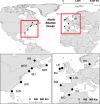Speciation and demographic history of Atlantic eels (Anguilla anguilla and A. rostrata) revealed by mitogenome sequencing
- PMID: 24865601
- PMCID: PMC4220719
- DOI: 10.1038/hdy.2014.44
Speciation and demographic history of Atlantic eels (Anguilla anguilla and A. rostrata) revealed by mitogenome sequencing
Abstract
Processes leading to speciation in oceanic environments without obvious physical barriers remain poorly known. European and American eel (Anguilla anguilla and A. rostrata) spawn in partial sympatry in the Sargasso Sea. Larvae are advected by the Gulf Stream and other currents towards the European/North African and North American coasts, respectively. We analyzed 104 mitogenomes from the two species along with mitogenomes of other Anguilla and outgroup species. We estimated divergence time between the two species to identify major events involved in speciation. We also considered two previously stated hypotheses: one where the ancestral species was present in only one continent but was advected across the Atlantic by ocean current changes and another where population declines during Pleistocene glaciations led to increasing vicariance, facilitating speciation. Divergence time was estimated to ∼3.38 Mya, coinciding with the closure of the Panama Gateway that led to reinforcement of the Gulf Stream. This could have advected larvae towards European/North African coasts, in which case American eel would be expected to be the ancestral species. This scenario could, however, not be unequivocally confirmed by analyses of dN/dS, nucleotide diversity and effective population size estimates. Extended bayesian skyline plots showed fluctuations of effective population sizes and declines during glaciations, and thus also lending support to the importance of vicariance during speciation. There was evidence for positive selection at the ATP6 and possibly ND5 genes, indicating a role in speciation. The findings suggest an important role of ocean current changes in speciation of marine organisms.
Figures




Similar articles
-
Speciation history of European (Anguilla anguilla) and American eel (A. rostrata), analysed using genomic data.Mol Ecol. 2020 Feb;29(3):565-577. doi: 10.1111/mec.15342. Epub 2020 Jan 2. Mol Ecol. 2020. PMID: 31863605
-
Genomic footprints of speciation in Atlantic eels (Anguilla anguilla and A. rostrata).Mol Ecol. 2014 Oct;23(19):4785-98. doi: 10.1111/mec.12896. Epub 2014 Sep 22. Mol Ecol. 2014. PMID: 25155907
-
Assessing pre- and post-zygotic barriers between North Atlantic eels (Anguilla anguilla and A. rostrata).Heredity (Edinb). 2017 Mar;118(3):266-275. doi: 10.1038/hdy.2016.96. Epub 2016 Nov 9. Heredity (Edinb). 2017. PMID: 27827390 Free PMC article.
-
A century of research on the larval distributions of the Atlantic eels: a re-examination of the data.Biol Rev Camb Philos Soc. 2015 Nov;90(4):1035-64. doi: 10.1111/brv.12144. Epub 2014 Oct 8. Biol Rev Camb Philos Soc. 2015. PMID: 25291986 Review.
-
A comprehensive hypothesis on the migration of European glass eels (Anguilla anguilla).Biol Rev Camb Philos Soc. 2020 Oct;95(5):1273-1286. doi: 10.1111/brv.12609. Epub 2020 May 13. Biol Rev Camb Philos Soc. 2020. PMID: 32406196 Review.
Cited by
-
Stable species boundaries despite ten million years of hybridization in tropical eels.Nat Commun. 2020 Mar 18;11(1):1433. doi: 10.1038/s41467-020-15099-x. Nat Commun. 2020. PMID: 32188850 Free PMC article.
-
Do North Atlantic eels show parallel patterns of spatially varying selection?BMC Evol Biol. 2014 Jun 20;14:138. doi: 10.1186/1471-2148-14-138. BMC Evol Biol. 2014. PMID: 24947556 Free PMC article.
-
Influence of life-history traits on mitochondrial DNA substitution rates exceeds that of metabolic rates in teleost fishes.Curr Zool. 2024 Aug 24;71(3):284-294. doi: 10.1093/cz/zoae045. eCollection 2025 Jun. Curr Zool. 2024. PMID: 40620590 Free PMC article.
-
Mitochondrial genomes of the Baltic clam Macoma balthica (Bivalvia: Tellinidae): setting the stage for studying mito-nuclear incompatibilities.BMC Evol Biol. 2014 Dec 21;14:259. doi: 10.1186/s12862-014-0259-z. BMC Evol Biol. 2014. PMID: 25527898 Free PMC article.
-
Mesozoic mitogenome rearrangements and freshwater mussel (Bivalvia: Unionoidea) macroevolution.Heredity (Edinb). 2020 Jan;124(1):182-196. doi: 10.1038/s41437-019-0242-y. Epub 2019 Jun 14. Heredity (Edinb). 2020. PMID: 31201385 Free PMC article.
References
-
- Albert V, Jonsson B, Bernatchez L. Natural hybrids in Atlantic eels (Anguilla anguilla, A-rostrata): evidence for successful reproduction and fluctuating abundance in space and time. Mol Ecol. 2006;15:1903–1916. - PubMed
-
- Als TD, Hansen MM, Maes GE, Castonguay M, Riemann L, Aarestrup K, et al. All roads lead to home: panmixia of European eel in the Sargasso Sea. Mol Ecol. 2011;20:1333–1346. - PubMed
-
- Alves-Gomes JA. Systematic biology of gymnotiform and mormyriform electric fishes: phylogenetic relationships, molecular clocks and rates of evolution in the mitochondrial rRNA genes. J Exp Biol. 1999;202:1167–1183. - PubMed
-
- Avise JC, Ball RM, Arnold J. Current versus historical population sizes in vertebrate species with high gene flow—a comparison based on mitochondrial-DNA lineages and inbreeding theory for neutral mutations. Mol Biol Evol. 1988;5:331–344. - PubMed
Publication types
MeSH terms
Associated data
- Actions
- Actions
- Actions
- Actions
- Actions
- Actions
- Actions
- Actions
- Actions
- Actions
- Actions
- Actions
- Actions
- Actions
- Actions
- Actions
- Actions
- Actions
- Actions
- Actions
- Actions
- Actions
- Actions
- Actions
- Actions
- Actions
- Actions
- Actions
- Actions
- Actions
- Actions
- Actions
- Actions
- Actions
- Actions
- Actions
- Actions
- Actions
- Actions
- Actions
- Actions
- Actions
- Actions
- Actions
- Actions
- Actions
- Actions
- Actions
- Actions
- Actions
- Actions
- Actions
- Actions
- Actions
- Actions
- Actions
- Actions
- Actions
- Actions
- Actions
- Actions
- Actions
- Actions
- Actions
- Actions
- Actions
- Actions
- Actions
- Actions
- Actions
- Actions
- Actions
- Actions
- Actions
- Actions
- Actions
- Actions
- Actions
- Actions
- Actions
- Actions
- Actions
- Actions
- Actions
- Actions
- Actions
- Actions
- Actions
- Actions
- Actions
- Actions
- Actions
- Actions
- Actions
- Actions
- Actions
- Actions
- Actions
- Actions
- Actions
- Actions
- Actions
LinkOut - more resources
Full Text Sources
Other Literature Sources

